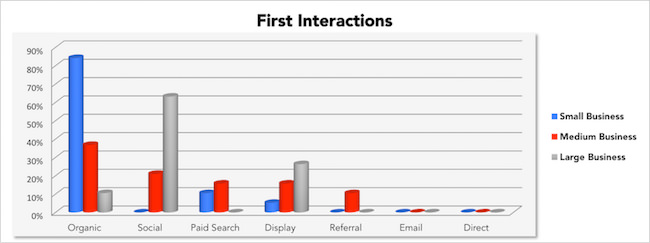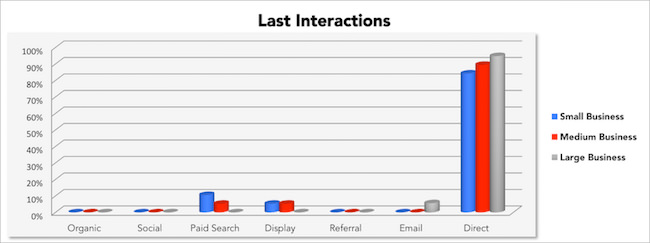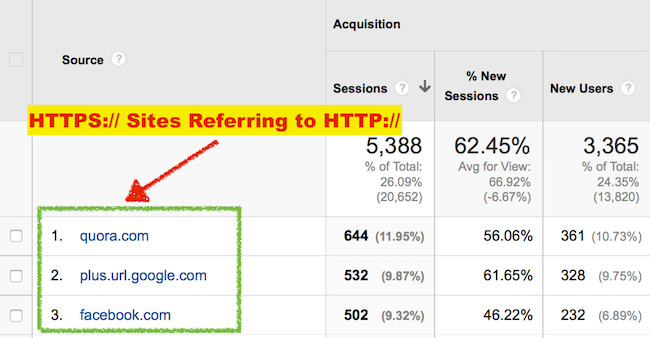Decoding Direct site visitors In Google Analytics
may just 26, 2015
quick answer:
Direct visitors = a discuss with to your website online and not using a identified referral supply.
That solutions the “what“. How concerning the “why“? in this post, you’ll analyze:
- the value of direct site visitors
- Why you may have a lot direct traffic
- how to cut back your direct traffic
1. Is Direct visitors valuable?
Google printed an interactive post showing the client path to on-line buy. the info is segmented by using trade, business size (small, medium, large) and sourced from thousands and thousands of Google Analytics profiles. the use of their data, I put collectively my very own diagnosis. I broke it into two sections:
- First contact attribution / interaction. The site visitors supply driving users to a web site for the primary time.
- final touch attribution /interaction. The site visitors supply riding customers to a site for the final time (aka conversion).
The goal is to point out how direct traffic plays into your general efforts.
natural, social and show are the leading sources of discovery visitors.
Are you seeing the identical factor i am? Direct traffic is through some distance the commonest remaining contact attribution channel. Let’s dig into it more to search out answers.
2. Why Do i’ve so much Direct traffic?
Direct visitors will also be broadly traced from three sources:
- customers journeying your web page straight away
- When a website online’s referral data is now not handed
- Untagged marketing campaign site visitors
I’ll walk you thru each of those.
Direct traffic supply #1: users visiting site straight away
users travelling your web page in an instant, aka typing your precise URL into their browser, is especially as a result of 2 issues:
- A well known brand
- Offline promoting
despite the fact that you meet each of those requirements, I’m willing to guess this is the smallest element of direct site visitors you’re receiving. Let’s say you’re working the billboard below:

I’m riding down the road, I see it and think “Holy shit! This billboard speaks to me – I need to visit their website online…NOW!”. I pull out my telephone and sort in the URL. well, I try to anyways. What I really type is one thing alongside the lines of “pulltheplguonatheims.com.” This gibberish redirects me to a Google search, which appropriately lists the URL. extra regularly than no longer, offline promotion leads to a rise in branded search, no longer direct visitors. which you can take a look at your branded queries in Google Webmaster instruments:
- Search visitors > Search Analytics
- make a selection: Clicks, Impressions, CTR
- make a choice: Queries
What you’ll see is the hunt queries over the date you selected. simply filter out non branded search phrases and also you’ll be left with branded queries.
here are two further questions to help resolve if persons are touring your website right away: question 1: Am I blocking off inside IPs? Your workers, contractors and purchasers generally get admission to your site lots. in case you aren’t filtering out their IP tackle, they’re a likely culprit for direct site visitors (by way of typing your URL verbatim). You will have to be blockading inside traffic for your Analytics account – should you aren’t, you want to read my blog more! query 2: Is my direct site visitors coming from new or returning users? in case your direct visitors is coming mostly from return visits, then there’s a great opportunity customers are journeying your web site instantly. here’s how to test:
- Navigate to Acquisition > All visitors > supply / Medium
- click on on (direct) / (none)

As you will see that, my web page does seventy seven% new visits from direct site visitors. again, for non brand sites, this is typical. due to this fact, your direct visitors is perhaps no longer coming from customers immediately typing your handle.
complete amount of YOUR direct traffic: 5 – 10%
Direct visitors supply #2: Referral information not handed
When referral data not handed, Google Analytics classifies it as direct visitors. There are dozens of causes for this, but I’m going to quilt the 7 commonest situations:
1. HTTPS:// referring to non HTTPS:// (HTTP://) sites
HTTPS:// is a secure model of HTTP://.

When HTTPS:// websites ship traffic to non HTTPS:// sites the browser doesn’t pass referral information. this is as a result of security reasons. if your website online isn’t on HTTPS://, it’s contributing to your direct traffic. This isn’t always the case. websites like fb and Twitter are HTTPS:// secure yet they express up as referrals.
this is for two reasons:
- They use a redirect script. These web sites first ship users to an intermediate HTTP:// site sooner than the tip referral. That’s why Twitter presentations up as t.co on your Analytics account. the usage of this intermediate redirect helps social networks to offer protection to PII data.
- they have got a vested pastime. These sites make money on their ability to pressure traffic. if you couldn’t test that they have been the source, you wouldn’t spend time, effort and tools on those web sites.
2. site visitors from non internet doctors (PDFs, phrase, Excel, and many others.)
hyperlinks from offline paperwork like Excel, PowerPoint, and phrase do not cross referral knowledge. I send out round 100 paperwork per week:
- Proposals
- reviews
- courses

Over time, these clicks can add up and make up a excellent component of direct traffic.
three. traffic from Apps
virtually no functions pass referral information. that includes:
- mobile apps
- Social media apps (facebook games, etc.)
- laptop apps (purposes downloaded to your laptop)
site visitors from these sources are dumped into direct.
4. hyperlinks with “noreferrer” attribute
Some links are tagged with “rel=noreferrer” attribute. in this case, referral knowledge is not passed.
example:<a hres= “http://webris.org/blog/” rel=”noreffer” > No knowledge will pull through</a>
5. links from desktop email clients
Do you employ Outlook from your computer? millions of individuals do. Any links coming opened from laptop Outlook (i.e. links you ship by way of e mail, signature, and so forth) go no referral data.
6. blunders in your GA script
in case you didn’t hire an Analytics professional to put into effect your code, there’s a just right exchange it’s not proper. frequently instances cookie information isn’t properly set up causing resets – these periods pass no referral data.
7. Redirects
for those who’ve ever redirected one web site into any other, referral data can get misplaced in between. for instance, we not too long ago modified our domain from marketic.co to webris.org. We arrange a server facet redirect (301) from the previous into the new. Marketic.co did about 1,000 referral visits a month. a variety of those legacy hyperlinks that still riding site visitors don’t move referral knowledge, as the JavaScript tag can get lost within the redirect (aka the “hop”).
total quantity of YOUR direct site visitors: 30 – 50%
Direct visitors source #3: Untagged marketing campaign traffic
through “Untagged,” I imply without Analytics tracking parameters. if you use Google Analytics, they offer a free instrument that makes tagging URLs easy. Tagging hyperlinks prior to publishing permits you to dictate to Analytics where the site visitors comes from. I promote my content in every single place. forums, e-mail signatures, social media teams, social media profiles, weblog comments – each position they let me drop a hyperlink, i will. these types of sites fall into the categories listed above (aka don’t cross referral supply). within the subsequent part, I give actionable guidance learn how to monitor efforts using marketing campaign parameters.
complete quantity of YOUR direct visitors: 25 – fifty five%
three. How can i reduce Direct visitors?
answer 1: Tag the whole lot
I mean the whole thing. Offline medical doctors, social media posts, forum signatures – the whole thing! most people don’t tag URLs because they think it’s a pain in the ass. neatly, it is a ache in the ass, however i’ve an simple short minimize.
Let’s say you’re on your favourite forum and also you come across a extremely energetic thread. You make a decision so as to add a comment and drop a link to a associated piece of content in your site.

Any of you get that reference? No? k, I digress… the purpose is, tag the link earlier than you publish it. It’s straightforward, here’s how:
- install the Google Analytics URL Builder browser plug in.
- click on it to open it.
- Paste your URL that you plan to share in the first box.
- supply: enter the website online/forum/blog identify.
- Medium: on this case it will be referral. You’re sensible sufficient to figure it out…
- campaign: enter a novel tag to help you establish it.
here’s what i’d enter to tag a hyperlink for Warrior discussion board:
versus getting dumped into (direct) / (none), the info will show up as you tagged it. See under:

solution 2: Dig into Analytics
once in a while that you can’t tag a link. for instance:
guest blogging:
I visitor submit as a hyperlink constructing tactic. most of the time, the web sites I write for are on HTTPS:// protocols, meaning the referral data received’t go to my Analytics. I could tag the links in the URL builder, however that causes an seo problem. Tagged URLs do not redirect to the root URL.

This items a possible problem with link fairness. since the tagged URL remains, technically, you’re constructing a link to some other URL. Let me illustrate with an instance. Let’s say I write a killer weblog submit about web optimization for small businesses and i wish to rank it. to take action, i would like links. So I put it up for sale via guest running a blog. The URL indexed by way of Google is:
http://webris.org/content/

option 1: I write a guest publish and link to my target content material. The link passes fairness, but I’m unable to trace referral traffic throughout the link.

possibility 2: I tag the hyperlink. i can track the referral traffic, but run the danger of losing the hyperlink’s equity. ahead of you shit a brick, let me explain! i know Google ignores the tags after the root URL. There’s lots of healthy debates about this, but here’s my take:
Tagging a link on every other web site factors to an unnatural link scheme. Why would a pure, editorial, non paid link have URL tags? It wouldn’t.
I hyperlink out to other websites always and i would never, ever tag the URL for them. That’s simply my two cents – tag at your individual chance!
Profile links:
There’s only one location Instagram permits links: your profile. The community also does now not go referral data. I frequently handle my shopper’s Instagram advertising, so it’s vital I measure the affect of my efforts.
![]()
I might tag it, however it might go away an unsightly ass URL within the profile. I might additionally dump the tagged URL into a bit of.ly, however people like to look what they’re clicking on. So, how do I monitor the efforts from guest posting and Instagram? by means of digging into Analytics. 1. Log into Google Analytics and navigate to: Acquisition > All visitors > source/Medium. 2. Set the date to short, recent time classes. i love to study on Saturdays for the earlier week.
three. click on (direct) / (none)
four. On the Secondary Dimension drop down, make a choice touchdown page
by means of assessing the touchdown pages of direct site visitors from a recent period of time, that you would be able to get a excellent image where the site visitors came from. Let’s take per week at my high three (direct) / (none) traffic for the last few days:
- / – I infrequently depart hyperlinks to my home web page, so i will be able to deduce this site visitors is coming from naturally generated hyperlinks. additionally, by looking the site visitors volume i can inform they’re almost certainly coming from quality sites.
- /weblog-web optimization/ – I did some guide outreach this previous week to promote that blog post. i stopped up connecting with any person who agreed to characteristic it on their email checklist. I’m 90% certain that’s where this traffic is coming from.
- /ultimate-listing/ – I promoted this content on Inbound and increase Hackers this week. I used to be lazy and didn’t tag the content material (my mistake). I’m virtually certain the site visitors is coming from there.
As you’ll find, there’s no actual science. then again, there are some further steps that you would be able to take to make lifestyles more uncomplicated. as an example, in the event you look at the screen of my Instagram account (above), you’ll discover the link in my profile isn’t to my residence web page. It’s a deep link to my non-public consulting page. If I need to learn the way a lot site visitors I’m getting from Instagram, all i’ve to do is run the record above with a few additional steps:
- Acquisition > All traffic > supply/Medium
- Filter for the consulting URL
- Layer on mobile site visitors section
- On the Secondary Dimension drop down, make a selection landing page
There you go – that’s how a lot site visitors my Instagram profile is driving.
resolution three: set up HTTPS://
if you want to reduce down on a big portion of direct traffic, migrate your website to a stable HTTPS:// connection. to take action, you’ll wish to purchase an SSL certificates out of your net host. For more data on the matter, test along with your net host.
Wrapping It Up
while there are a variety of tips on how to reduce down on direct traffic, be mindful web analytics isn’t an exact science. There’s no approach to get rid of it utterly. however, following the steps laid out here will go an extended approach to assist. Did I miss the rest? go away your techniques to find direct visitors in the comments beneath!
This publish is syndicated from Webris.
Digital & Social Articles on industry 2 group
(236)

























